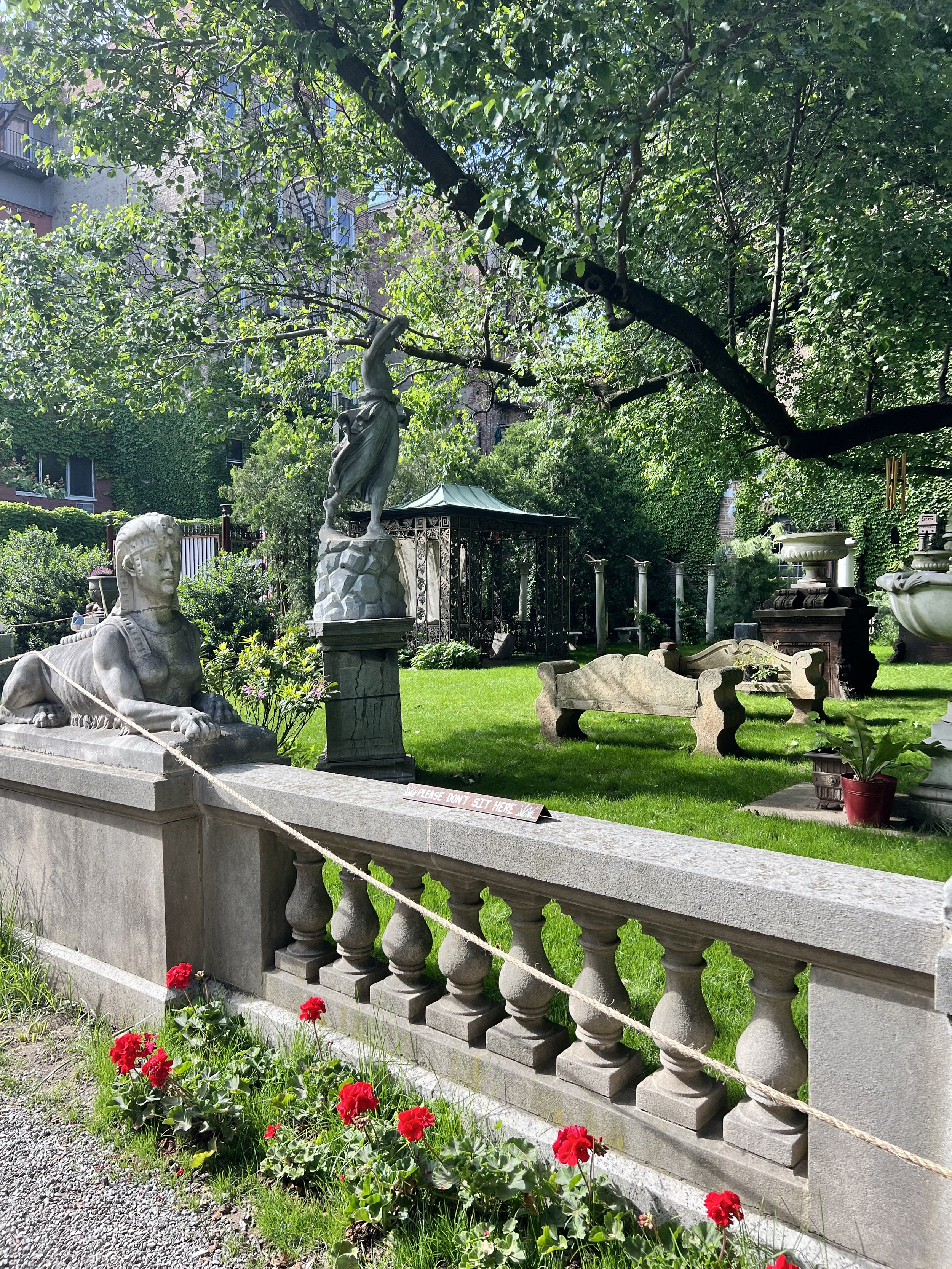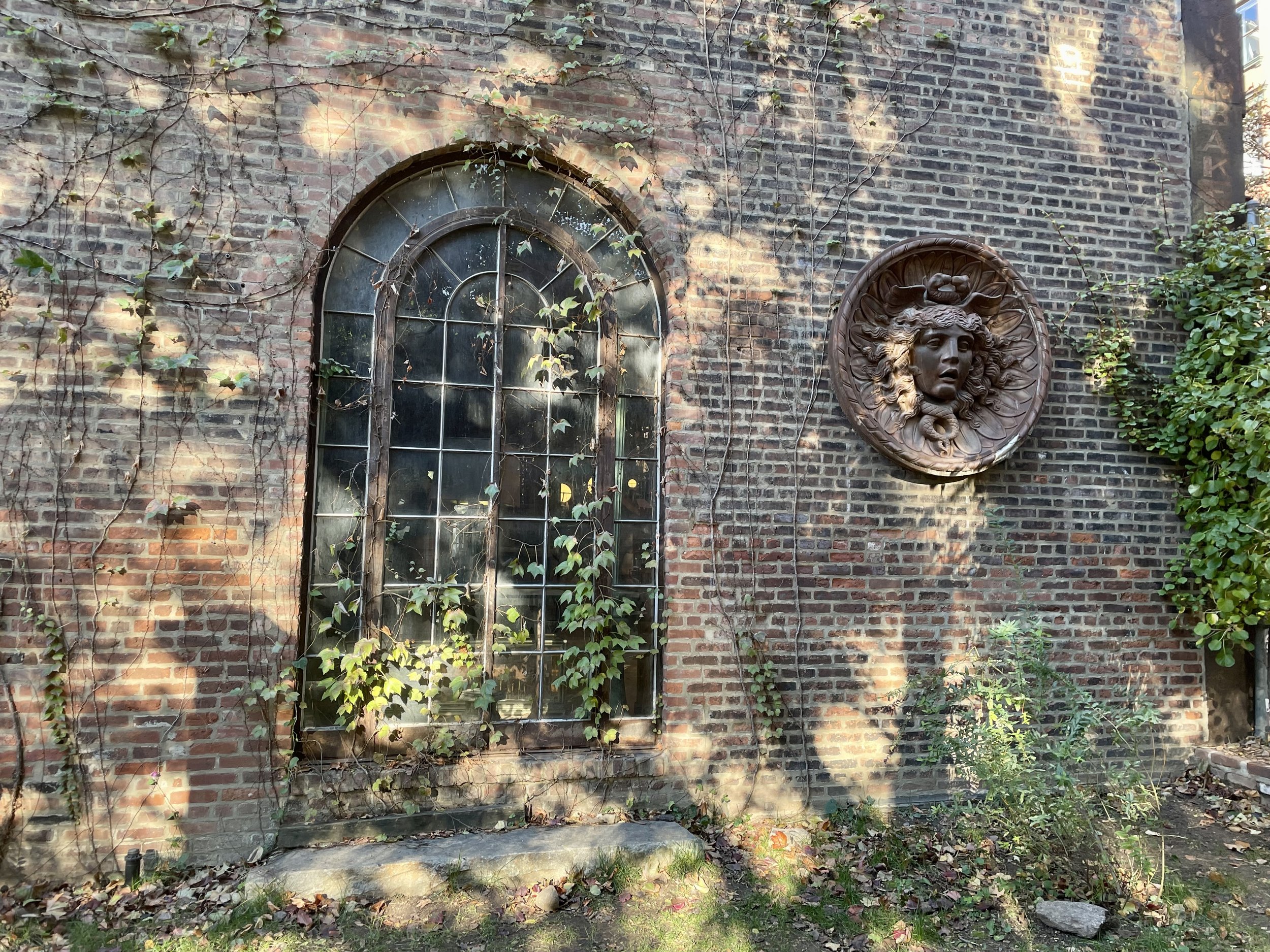The Elizabeth Street Garden
Hidden in Soho on Elizabeth Street lies one of New York City’s hidden gems…
As you walk up Elizabeth street, past the fruit and fish stands of Chinatown and the quaint restaurants of Little Italy, you see a cluster of trees spilling out onto the sidewalk. Intrigued, you venture towards them and walk between two rusted, chain-linked fences that mark the entrance to the Elizabeth Street Garden. Trudging forward, with your latte in one hand and book in the other, you sit down on one of the mossy stone benches, and sink into a trance, oblivious to the locals, tourists, children, and adults enjoying the garden around you. Looking up from your book, you see artists painting portraits of the stone-carved lions and angels, a group of friends catching up around an antique wood table, and students and workers eating their lunch, bopping to their favorite music.
Crammed between Little Italy and Soho lies the Elizabeth Street Garden, a serene oasis isolated from the commotion of the city around it.
The Elizabeth Street Garden (ESG) is a non-profit organization whose mission is to preserve the garden for future generations. The ESG is the only open, public space for all ages in Little Italy and Soho.
The garden itself is roughly 20,000 square feet and is located between Prince and Spring street, in the middle of Elizabeth and Mott Street. The entrance to the garden is on Elizabeth Street, next to the Elizabeth Street Gallery, a space that holds countless antique items reminiscent of the ones scattered around the garden. Upon entering, on the left will be several seating areas surrounded by trees, bushes, and antique structures. On the right lies a green lawn housing several statues, benches, tables, chairs, trees, and a gazebo. Along the main path, there are other seating areas, small crop gardens, and a large barn-like structure at the back of the garden. The stone statues are of angels, lions, dogs, and mythical creatures, and they inhabit the garden, bringing it to life and giving the garden its unique whimsical sense. These statues were initially brought to the garden by Allan Reiver, the founder, and creator of the Elizabeth Street Garden, from his personal collection in his gallery and home.
The copper Medusa at the back of the garden and the stone lions are among the countless decorative statues in the garden, but they are most symbolic as they are represented in ESG’s logo.
How did the Elizabeth Street Garden come to be?
In the early-to-mid 1800s, the garden used to be Public School No.5, a school that carried out regular schooling during the day, in addition to free night classes for people of color. Over the years, a series of expansions and improvements were made to the school, including the addition of large recreational and outdoor spaces. Then, in the 1970s, the school was demolished, leaving an empty lot that in 1990 was granted to Reiver by Community Board 2 of Manhattan. Shortly thereafter, Reiver moved his antique stone statues and sculptures into the lot and opened it up to the public. He promptly planted lush trees, paved a gravel path, created wooden structures, and moved in more stone benches and statues that are so iconic to the garden today.
The fight to preserve the garden is not as pretty as the garden itself.
ESG, the City of New York, and the Department of Housing Preservation and Development (HPD) have been (and continue to be) in a legal battle after the ESG filed a lawsuit against the city and the HPD.
This lawsuit is in opposition to the city and the HPD wanting to replace the garden with affordable housing units. As explained by Isabella Neihardt, a volunteer coordinator and fundraising volunteer for ESG, “because the city owns the land, they have rights to it that we do not, and they want to develop the land into a multi-use building with ground floor retail office space for Habitat for Humanity - which is pretty wild.” ESG argues that the garden should stay standing and continue to provide New Yorkers with a green space isolated from the tumult of the surrounding neighborhoods: Chinatown, Soho, and Little Italy.
The city has “essentially pitted green space against affordable living- which is a really messed up thing to do”, says Neihardt.
ESG has even suggested alternative sites for affordable housing, all of which have the potential to offer more units and facilities than the ESG lot would. As summarized by Neihardt, “we’ve suggested an alternative site where they could build 5 times the housing… and basically, they came back to us and said ‘oh great we’ll build there too’!”
Why should we preserve the Elizabeth Street Garden?
There is an affordable housing crisis and a green space crisis in New York - both are equally important, however, in Soho and Little Italy, the green space crisis is more of a problem. The Elizabeth Street Garden is the only green space in these two neighborhoods, making it even more important to preserve it as there is no convenient alternative nearby.
Soho and Little Italy make up 23% of the population of Manhattan Community Board 2 but only account for 3% of the area’s open space. Without the Elizabeth Street Garden, 23% of Manhattan Community Board 2 would lose any open, green space in their neighborhoods.
According to Neihardt, “this garden is one of the only green spaces in this neighborhood, in this district, [and] without it there would not only be a lack of green space, but you would lose a large part of this community.” She then goes on to say how the garden is important to the locals, “including the elderly people who live nearby, the Chinese community, some Italian-Americans who have been here for a very long time, to tourists, to businesses, to so many people, myself included.” For the elderly, “it provides [them] a place that’s in walking distance”, rather than going to Washington Square Park (the city’s alternative for the ESG), which given its proximity to NYU, and it being “NYU’s playground”, isn’t quite the tranquil oasis of ESG the elderly community enjoys so much.
How does the community impact the future of the garden?
ESG has gained seemingly unanimous support from the New York community. Through protests and community events, people have gathered around this central cause: keeping the Elizabeth Street Garden alive and preserving it for future generations. Without the community’s support, the ESG would not have been able to rise above the city’s allegations to remove it, would not have been able to improve over time, and would not be here today where it stands strong with New Yorkers, working together to let the Elizabeth Street Garden be a permanent part of the city’s future.
How can you help?
DONATE:
ESG is still pursuing its lawsuit against the city and HPD, and they need your help. Every day, volunteers like Neihardt have been collecting donations at the garden, and according to her, “right now about 90% of all donations fund our lawyer, but we hope that in the future [after the lawsuits], we can use the money raised to improve the garden directly.” ESG has plans to introduce more community events, make the garden more usable and maintained, and build a greenhouse to grow crops all year round.
VOLUNTEER:
As the ESG doesn’t have enough funds to hire people to monitor the garden, it is completely run by active volunteers. Volunteers help directly by cleaning and maintaining the garden, but also regulate donation booths and community events.
SPREAD THE WORD:
It’s imperative to spread the word about the Elizabeth Street Garden, letting people know what they stand for and why the garden should be preserved. Speaking about the garden through media like TEENSY is vital for letting ESG’s voice be heard. Too often ESG is misrepresented and misunderstood, and the only way to counteract that is through telling their story from their perspective.
ESG is not anti-affordable housing, and has suggested better affordable housing sites, but believes preserving the Elizabeth Street Garden for the surrounding communities is more important.
As New Yorkers, surrounded by constant urbanization and development, it’s of increasing significance to hold on to the few community-oriented places we have left. The Elizabeth Street Garden reminds us of the importance of open, green space, but also makes us realize how New Yorkers can unite around a central cause and actually make a difference.



